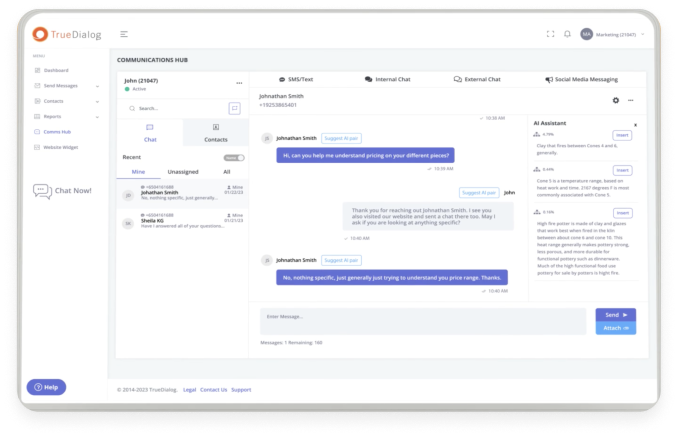Small Businesses are Tapping Into a Smarter Way to Communicate with customers – Using SMS on Long Codes
Pain Point:
A small business, such as a real estate agent, has the on-going communication issue that so many of us have. It’s difficult to pin down your clients and connect with them while they are always on-the-go. Many real estate agents are using SMS (text messaging) to stay in contact real-time with their clients, but doing so from your own phone all of the time is not so simple either. The costs can get out of control very quickly, and agents want the client to still feel the personal / local touch.
Mobile Tool:
SMS from a local Long Code
Use Case:
The local real estate agent has 2 key goals: connecting with new prospects as quickly and easily as possible and staying connected with current clients while in the process of searching for/closing a home. Since young couples and similar home buyers are using their phones more and more (for both work and personal life), it is easy to connect using SMS.
The first goal of engaging prospective home buyers requires some external signage and a series of helpful SMS campaigns. It begins with a “welcome + more info” style campaign for the prospects. When someone drives past a house and sees a sign that reads “Text MOVEIN to 512-123-4567” and takes action, then the automated message back will provide basic info about that agent plus a link to view property details. The real estate agent can also receive a notification or view in a report that a specific contact (based on phone number) texted-in, so she knows to follow-up with that contact.
A different approach to the initial engagement process with a lead is offsite marketing – newspaper ads, social media, website, or other outdoor signage – that lead to a dialog campaign. This SMS campaign utilizes the SMS dialog feature of asking questions to determine the home buyer’s needs and wants. Gathering this data helps the local real estate agent to offer the best possible offerings to the contact/prospective client. Then the information about each contact (called contact attributes) can be synced with the agent’s customer database software for sending smarter and more targeted messages through all marketing channels.
The importance of using a long code, in part, is the experience of seeing a local phone number posted in the advertising rather than a short code (which is associated with marketing SMS). If you are a local business, then it is so key for your customers/clients to feel like they are engaging with a local business and not some giant conglomerate.
The second goal of staying connected with current clients uses SMS tools in a more long-term way. Keeping things very simple, an agent can simply use SMS through a platform as a better way for tracking communications. Instead of sending a text from his/her phone, the agent can send SMS from a desktop computer or tablet. The key differentiator in this experience are the improvements to the agent’s long-term reports and tracking communications.
However, a small business that wants something a little more robust can leverage the SMS API to be connected with a CRM system and send text messages using different triggers. When a home buyer completes a step in the buying process, such as putting in an offer, that is tracked in the CRM system, then a SMS message can be triggered by that change in the system. We can set it up in such a way that a pre-set text message is sent to the home buyer when that offer is either accepted or decline by the seller. It is one less step for the agent, while still fulfilling on a protocol.
The result of these upgrades is a smoother communication strategy. The small business real estate agent makes small upgrades to the communication plan and process, and in-turn improves the overall experience of buying a home. SMS offers a faster and more affordable approach to client communications while maintaining the local-feel using a long code.


